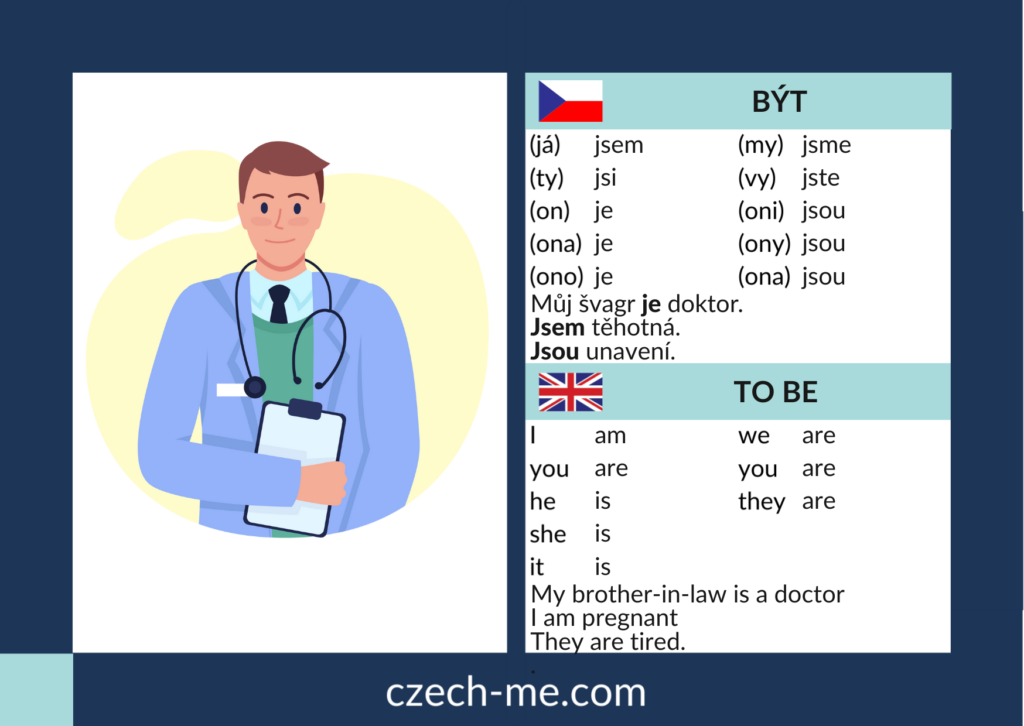Sloveso BÝT – Verb TO BE

Let’s start this series with the most important and most frequently used verb in Czech – the verb TO BE – BÝT. I will show you in this article not only the forms of the verb BÝT in Standard Czech, but also in Common Czech.
Present tense (Přítomný čas)
Let’s have a look at this study card that I have created for you:

What should you be aware of while learning the forms?
👍 We prefer NOT to use personal pronouns (eg. já/on/my) in most cases. That’s why I put the nouns into brackets.
How can we know if it’s he/I/we etc.? The form of the verb gives us all the necessary info.
Jsem těhotná. = I am pregnant.
x
Jsme doma. = We are at home.
👍 We use personal pronouns when we want to really highlight them.
Watch out! If you overuse JÁ, you may come across as self-centered/egoistic.
One Czech band even recorded a song about it. The song is called „JÁ“ and the band is OLYMPIC.
Here is a part of the song:
Každou větu začal slůvkem Já
Každou větu končil slůvkem -já
Jenom já
Já, já, já, jenom já, jenom já
Já, já, já, jenom já, jenom já
Já, já, já, jenom já
Já stačím si sám
Já, já, já, jenom já, jenom já
Já, já, já, jenom já, jenom já
Já, já, já, jenom já
Já stačím si sám
Já se mám
Let’s practise
Kde jsi? – Jsem v práci. (= Where are you? – I am at work.)
Kde je? – Je v Praze. (= Where is he/she? – He/She is in Prague.)
Jsi manažer/manažerka? – Ano, jsem. (= Are you a manager? (male/female) – Yes, I am.)
Proč jsou v Brně? (Why are they in Brno?)
What does the verb sound like when Czech people speak
aka Common Czech?
Czech language is challenging not only because of all the cases, perfective and imperfective verbs etc., but also because we use quite frequently different vocabulary for Standard Czech (the formal/official one) and other words or pronunciation for Common Czech (version that we use among friends and family or in less formal situations).
Is Common Czech used in the whole Czech Republic? Unfortunately, no. You will definitely hear it in Bohemia (for example in the region where I live which is the north of Bohemia or Prague).
Therefore I regularly include the forms or expressions from Common Czech on social media, into my articles or courses of Czech.
What’s the difference in present tense? Let’s have a look:
COMMON CZECH:
BEJT* = TO BE
(já) sem*
(ty) si*/seš*
(on/ona/ono) je
(my) sme*
(vy) ste*
(oni/ony/ona) sou*
As you can see, we prefer NOT to pronounce the initial J in most of the forms of the verb to be in Common Czech. So don’t be surprised if you hear /SEM/ doma instead of /JSEM/ doma (= I’m at home)…
Click for more practice:
If you want to practise the verb BÝT in a simple story, you can check my YouTube channel. You can not only listen to the story in Czech, but also read it. I have included more activities to activate your Czech as well.
There are different stories in Czech published regularly. The levels vary – from beginners to advanced learners. If you don’t want to miss a new one, subscribe.

And if you want more support, you can join my 3-month group course. I am currently working on different levels. You can find more info here.









